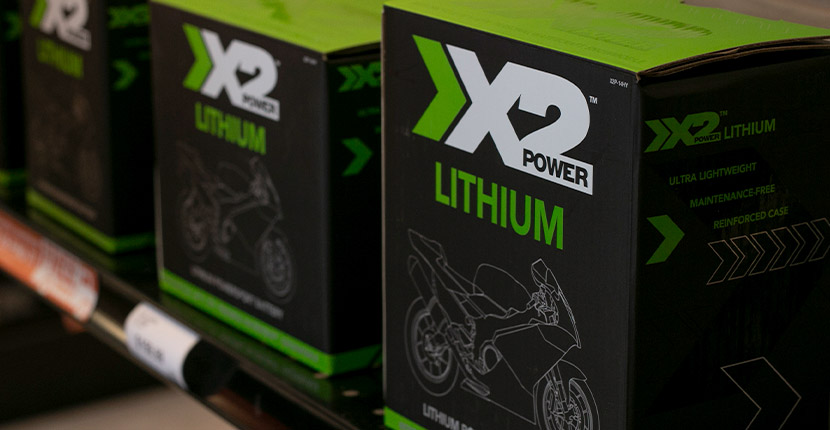What is a Lithium Iron Phosphate Powersport Battery and How Does It Work?
- by Bryan Veldboom - updated on 3/24/2022

If you're looking to get the best performance possible out of your motorcycle, ATV, UTV or personal watercraft you should consider investing in a lithium iron phosphate battery. Not only do lithium iron phosphate batteries outperform both flooded lead acid and AGM batteries, they're also the safest type of lithium battery in the powersport industry today.
What is the Difference Between a Lithium Battery and a Non-Lithium Battery?
Lithium iron phosphate (LiFePO4) batteries are a type of lithium-ion battery that can be used to power a number of vehicles that traditionally rely on lead acid batteries. LiFePO4 batteries have different cell quantities than lead acid batteries. While lead acid batteries feature 2 volt individual cells, LiFePO4 options have 3.2 volt cells. Additionally, a 12V lead acid battery has six cells in total, while a LiFePO4 battery has only four. This is because lithium has a greater energy density than lead.
The two also differ greatly in their rate of self-discharge. Lead acid batteries require you to charge them regularly when they're not in use. Lithium batteries don't require the use of a battery maintainer or float charger when in storage and can sit at a lower percentage without losing their charge or compromising their lifespan.
Lithium batteries are also free from many of the natural limitations that plague lead acid batteries. Because of their chemistry, lead acid batteries are prone to sulfation, active material depletion, slow charging and limited usable capacity. Since the lithium chemical process is more straightforward, it eliminates these unwanted reactions.
Are Lithium Batteries Better Than Lead Acid?
Due to their superior chemistry, LiFePO4 batteries outperform lead acid batteries in nearly every category. Here are some of the key advantages they have:
- Longer lifespans - Can last up to 2,000 cycles; roughly 4X longer than most powersport batteries
- Faster charging - Charges up to 2X faster than lead acid batteries
- Constant power throughout the battery's discharge
- Low self-discharge rate - Holds a charge for much longer in storage than flooded or AGM batteries
- Lightweight - 55% lighter than lead acid batteries
- Non-gassing - LiFePO4 batteries don't gas like lead acid batteries
- Equipped with a Battery Management System - Helps prevent overcharging or individual cell damage
- Longer warranty - an X2Power LiFePO4 battery has a 3-year warranty vs a 2-year warranty for a Duracell AGM battery
What are the Disadvantages of Lithium Iron Phosphate Batteries?
While LiFePO4 batteries outperform lead acid options in nearly every category, they will cost you more upfront. This higher cost is typically off-set by their longer lifespans though, which means you can end up saving money in the long run.
The one big disadvantage of lithium iron phosphate batteries is that they cannot be charged once the temperature drops below 32℉. For this reason, lithium batteries should not be used in snowmobiles or other winter-weather applications.
How Do You Charge a Lithium Phosphate Battery?
Powersport applications such as motorcycles and ATVs have their own charging systems, which charge your battery when the engine is running. If you only use your powersport vehicle sporadically though, or plan on storing it for longer periods of time, you'll probably want to pick up a battery charger. When selecting a charger, make sure the one you choose is compatible with the chemistry (lithium iron phosphate) and the voltage of your battery (12V for most vehicles).
Unlike lead acid batteries which should be kept as close to a 100% charge as possible, LiFePO4 batteries should be kept at around 50% during long term storage. Storing a lithium battery at a higher charge can cause the positive terminal to become unstable, leading to a permanent loss of capacity. A lithium battery will hold onto its charge quite well during storage, however, you'll still want to check it every few months. If it dips below a 30% state of charge, you should charge it back up to around 50%. Just like with any battery, be sure not to overcharge a lithium battery as this can damage it permanently. When taking a LiFePO4 battery out of storage, be sure to charge it prior to use if it is at less than a 50% state of charge.
Where Can I Buy Lithium Batteries?
Batteries Plus offers a huge selection of powersport batteries, including X2Power brand lithium batteries. X2Power is the best powersport battery on the market today and you can only find it at Batteries Plus. Learn more about the X2Power brand, then shop our selection of powersport batteries online. Looking for a charger for your lithium battery? These X2Power smart chargers can be used for motorcycles and all other powersport vehicles.
Want to learn more about lithium batteries? Read our blog articles entitled "How Do Lithium Iron Phosphate Batteries Perform in Cold Weather?" and "Why Your Business Should Switch to Lithium Iron Phosphate Batteries."